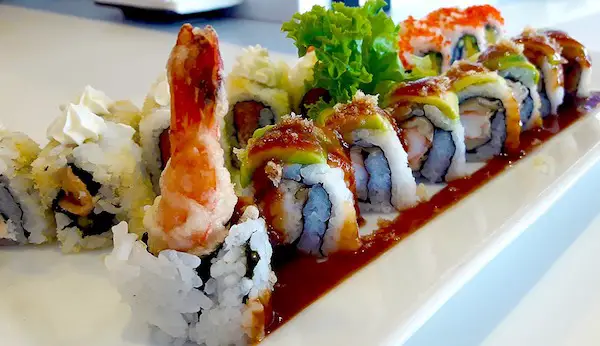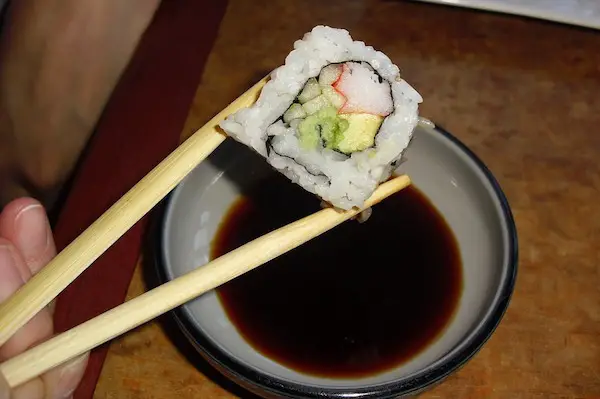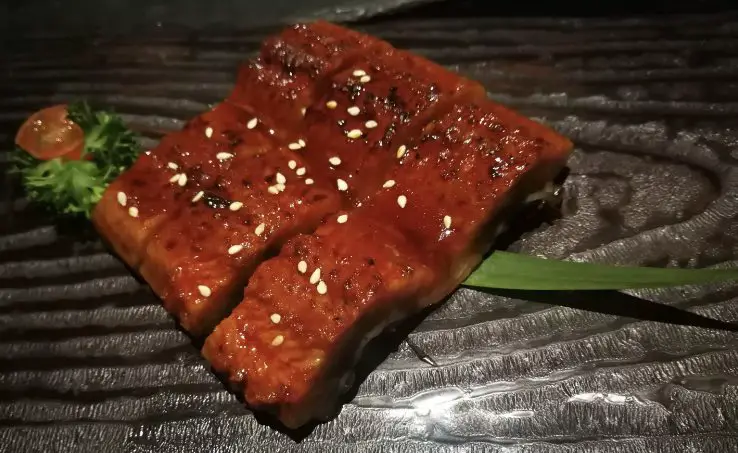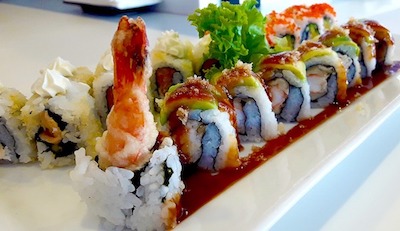We are reader supported. When you purchase through links on our site, we may earn an affiliate commission. Also, as an Amazon affiliate, we earn from qualifying purchases.

If you are a non-Japanese, it’s understandable if you have no idea about the flavorful black sauce served with sushi. The dish will not really taste the same without it. You will find numerous variations of this sauce in Japanese cuisine than any other food culture in this world.
So, what is the black sauce on sushi? If the black sauce is drizzled on top of the sushi then it is possibly teriyaki sauce and if it’s thicker like syrup then it could be eel sauce (nitsume). Some chefs may also use the tonkatsu sauce on top of modern fusion sushi dishes.
Tonkatsu sauce has a tangy taste while Teriyaki sauce is on the sweeter side. The chef may drizzle teriyaki sauce on unagi, tempura shrimp roll, caterpillar roll, dragon roll, and so on.
If the chef uses a light black sauce on sushi then it could be chirizu sauce, which goes well with fish like aji, halibut, and other shellfish. Another type of sauce that may be used on sushi is the ponzu sauce which has a typical sweet taste.
It’s interesting to note that all these brown to black sauces are soy-sauce based and vary slightly in terms of flavor, taste, color, and texture. If the sauce is served in a separate bowl as a dipping sauce then it could be the original soy sauce, tamari sauce, ponzu sauce or chirizu sauce. Let’s look deeper into them:
Contents
Soy Sauce

Just like the fish and sushi rice, soy sauce is an important element of sushi that lends it a subtle flavor and aroma. It is typically made by processing four ingredients – soybeans, wheat, water, and salt. The original soya sauce or shoyu traces its roots to ancient China and today there are three different types of soy sauce available.
The light soy sauce has a reddish brown color and it is used for dressing, dips, and marinating ingredients. It has a strong and salty flavor. Dark soya sauce is slightly sweeter in taste with a thicker texture and caramel color that can dye other ingredients.
The thick soy sauce contains a higher percentage of wheat which gives it a thicker consistency. It has a sweet taste and often used as dips. To prepare a thicker soy sauce, mix together 300ml light soy sauce, 250ml water, 1.5 tsp cornflour, and 2 tbsp brown sugar in a pan and bring to boil. You may adjust the sweetness as per your liking.
Tamari Sauce

This is popularly known as the Japanese soya sauce. It is different from the Chinese version in many ways. It has a thicker consistency, less salty flavor, and is fermented with less amount of wheat. It is used in a variety of Japanese dishes to add a savory umami flavor.
Unlike Chinese soybean which is made by cooking soybeans with roasted wheat, tamari (see amazon) is the byproduct of miso paste. During the fermentation process, little to no wheat is added to the product, which makes it a perfect choice for those who have a gluten intolerance.
Many sushi restaurants may use tamari sauce in preparing food and also serve it as the side dip. If you are on a celiac diet, you may request you, sushi chef, to use only gluten-free tamari or carry a packet of the Japanese sauce in your bag when dining out.
Teriyaki Sauce
This is the black and sticky version of soy sauce used for glazing the fish on top of the sushi. It may also be drizzled over the toppings on a California roll (see recipes) to enhance the flavor. It has a bold flavor and thicker consistency that goes well with a variety of other dishes. Here’s a quick recipe to make your own black sauce to add on your homemade sushi.
Ingredients:
- 1/4 cup soy sauce
- 1/4 cup cold water
- 1 cup of water
- 5 tbsp brown sugar
- 1-2 tbsp honey
- 1 garlic clove, finely minced
- 1/2 tsp ground ginger
- 2 tbsp cornstarch
Mix all the above ingredients (except cold water and cornstarch) in a medium saucepan and place over the stove on medium heat. In a separate bowl, whisk together 1/4 cup cold water and cornstarch, and then add this mixture to the saucepan.
Bring to boil and then simmer until the desired consistency is achieved. If the sauces become too thick, add some water to adjust. When it cools completely, transfer to a bottle and refrigerate.
Eel Sauce (nitsume)

If your guy has fallen in love with the black sushi sauce on sushi then you will be delighted to know that it’s easy to make at home. Known as nitsume in Japanese, the sauce is typically used to blast or drizzle on grilled eel and other fish toppings on sushi. It has a sweet and salty flavor.
To make eel sauce at home, you will need just three ingredients – 1/2 cup soy sauce, 1/2 cup mirin (Japanese sweet wine), and 1/2 cup white sugar. Mix all these ingredients evenly in a saucepan, bring to boil and simmer until the content is reduced to 3/4th.
When the sauce cool, transfer to a jar and refrigerate. I have created an article on eel sauce where you can find more variations of this recipe, check it here.
Tonkatsu Sauce
This is another thicker and tastier version of soy sauce which may be used as a delicious marinade or drizzled over the fish toppings on your nigiri or uramaki rolls. It has a thick consistency and sweet taste that can enhance the flavor of any dish. Here’s a quick recipe to make Tonkatsu Sauce at home.
Ingredients:
- 1/2 cup ketchup
- 1 1/2 tsp Worcestershire sauce
- 2 tbsp soy sauce
- 1 tbsp brown sugar
- 1 tbsp mirin (Japanese sweet wine)
- 1 tsp grated fresh ginger
- 1 clove garlic, minced
Put all the ingredients mentioned above in a bowl and stir to make a homogenous mix. Allow the mixture to sit undisturbed for at least 30 minutes for the flavors to blend together.
Ponzu Sauce
This tangy flavored soy-based sauce is typically used as a dipping sauce, however, it may also be drizzled on your sushi to add flavor. Traditionally made by adding fresh citrus (lemon or orange) juice, it is believed to be inspired by Holland traders in the 17th century.
To prepare Ponzu sauce at home, you will need 1/2 cup of low-sodium soy sauce, 1/4 cup of fresh lemon or orange juice, I tbsp mirin or rice wine, 1 tbsp water, and 1/8 tsp red pepper (crushed). Mix all these ingredients in a bowl, cover with a lid and let it sit outside for some time. Transfer to a jar and refrigerate.
Nikiri Sauce (sweet soy sauce)
When talking about soy sauce used on sushi, nikiri sauce deserves a mention. Although it is not a black sauce, this sweetened light brown sauce is mostly applied over nigiri toppings to add a glaze to them. The sauce has a thinner texture and offers a burst of rich umami flavors.
To prepare nikiri sauce at home, you will need 1 cup of high-quality soy sauce,1 cup mirin, 1/ cup of homemade dashi (fish stock), 1.5 tablespoon sake. Mix all these ingredients in a saucepan and bring to simmer on low heat. Let the mixture evaporate for at least 15-20 minutes until you get a thickened syrup-like sauce.
Different Ways In Which The Black Sauce Is Used On Sushi
The traditional sushi dish in Japan did not have so many varieties of black sauce and it’s more of a recent addition commonly seen on California-style rolls. While in the past, the brownish-black soy sauce was only served as a dipping sauce, today you may find nigiris and rolls blasted with different types of sauce.
The chef already applies some amount of soy sauce on the fish part of nigiri or on the toppings or fillings in a sushi roll to give you a balanced flavor. As per sushi etiquettes, you must avoid adding any more sauce because by doing this you will distort the perfect balance of flavors created by the sushi chef.
For some sushi recipes, the raw fish may be marinated or grilled using soy-sauce to enhance the flavors. In uramaki or inside-out rolls, different variations of the black sauce are used for decoration. You may find teriyaki sauce, tamari sauce or plain dark soy-sauce drizzled over the toppings to create a beautiful presentation.
As the sushi evolves with more fusion recipes and contemporary ideas, you can find chefs using their own custom or secret soy-sauce recipe to differentiate from others. It has become a common practice for modern chefs to use one or more complementary sauces on the sushi rolls.
Related Questions
Why is soy sauce black in color
When the boiled soybeans are fermented, they turn black in color. Traditionally, soy sauce is prepared from a paste of fermented and boiled soybeans, roasted wheat, and sodium.
Is it against sushi etiquettes to dip sushi in soy sauce
When eating nigiri in a sushi restaurant, you must pick the piece with your chopsticks and only dip the fish part in soy sauce. Slathering your sushi with sauces or mixing wasabi with soy sauce is disrespecting the beautiful art created by the chef. I have created an article to help beginners learn about sushi etiquettes to help them build a rapport with the chefs and enjoy their experience to the fullest.
Which soy sauce brand is best for sushi
I prefer and recommend the Kikkoman Soy Sauce, which is prepared in the traditional way, unlike the other commercial brands that contain artificial additives and caramel coloring.
Is dark soy sauce the same as black soy sauce
In Thai food culture, the dark soy sauce is often referred to as black soy sauce. It is typically thicker in consistency, less salty than regular sauce, and has a darker appearance often due to the presence of caramel.
Can I substitute dark sauce with light sauce in recipes
You can substitute dark soy sauce with lighter versions if you have run out of it. The taste will almost remain the same but the color may not be as good. However, using the dark version in recipes that require light soy sauce is not a good idea as this may overpower the subtle flavors of other ingredients.
See Also:
What Is The Orange Sauce On Sushi?
What is Kinki (Channel Rockfish)?
Is Shaggy Dog Sushi Cooked?
Do You Eat Sushi Hot Or Cold?
10 Common Sushi Making Mistakes for Beginners

